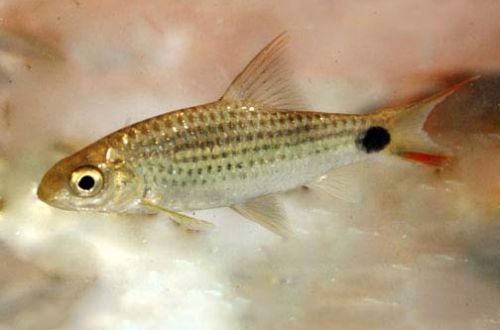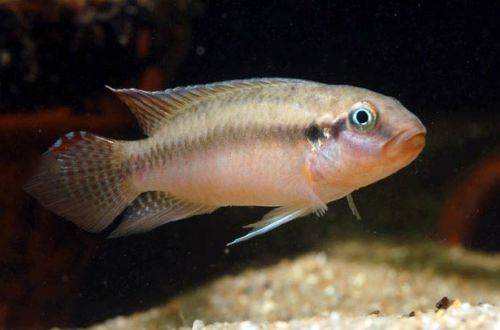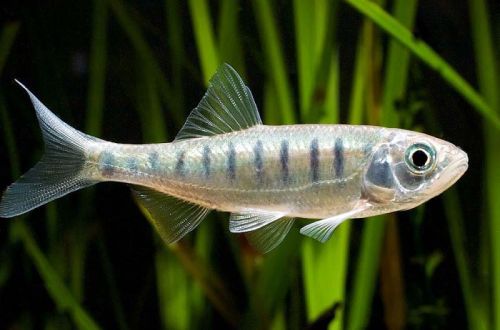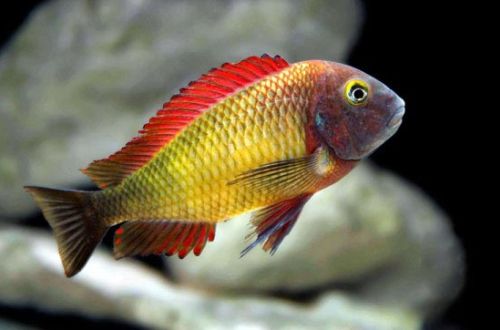
Tropheus Moura
The Tropheus Moore or Blunt-nosed Cichlid, scientific name Tropheus moorii, belongs to the Cichlidae family. Endemic to Lake Tanganyika in East Africa, found in shallow waters along rocky coastlines. Despite its popularity and ease of maintenance, this species has one significant drawback – it is excessive aggression towards relatives, therefore more than one such fish is rarely found in a home aquarium.

Contents
Description
Adult individuals reach a length of about 14 cm. Sexual dimorphism is poorly expressed, it is problematic to distinguish a male from a female. There are about 50 subspecies of the Blunt Cichlid, each with its own original coloration and body pattern. Nutritional features determined the structure of the mouth of this fish. It is set low, lips have acquired hard edges, allowing them to scrape vegetation from stones.
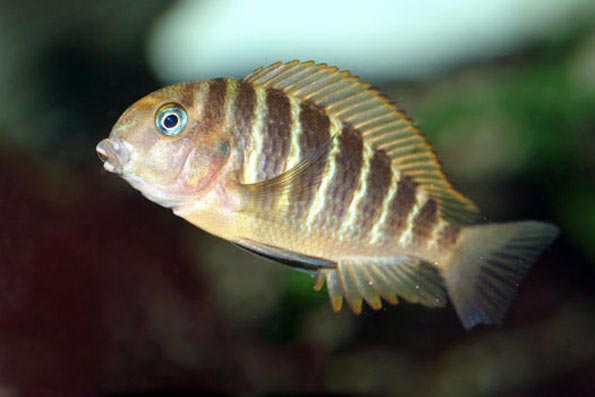
Brief information:
- The volume of the aquarium – from 100 liters.
- Temperature – 23-27°C
- Value pH — 8.0–9.5
- Water hardness – medium to high hardness (10-25 dGH)
- Substrate type – sandy
- Lighting – moderate
- Brackish water – no
- Water movement – weak, moderate
- The size of the fish is about 14 cm.
- Nutrition – any with vegetable and protein supplements
- Temperament – conditionally peaceful towards other species, but aggressive towards relatives
- Keeping alone in a small aquarium
Food
In nature, it feeds on algae growing on the surface of rocks and stones, and small invertebrates, crustaceans that live in this vegetation. At home, it is recommended to use specialized food for Lake Tanganyika cichlids, produced by many manufacturers, or purchase universal food, which should contain a large number of plant components.
Maintenance and care, arrangement of the aquarium
The optimal size of the aquarium for one fish starts from 100 liters. The design is quite simple, a sandy substrate and several large stones, rocks, from which caves, grottoes or any other decorative elements are built. There is no need for plants.
Particular attention should be paid to the quality and composition of water. Fish need very clean and oxygenated water with high pH and hardness. Along with the weekly replacement of part of the water (15–20% of the volume) with fresh water, a prerequisite is the availability of a productive filtration system, preferably with filter materials that maintain the required hydrochemical composition of water.
Behavior and Compatibility
This species has a reputation for being very aggressive fish, but this is not entirely true. Such behavior is manifested exclusively in relation to their relatives, who arrange death duels for dominance. To other species, Tropheus Mura is quite friendly and can be successfully kept in the company of many popular fish that can live in similar conditions.
A blunt-nosed cichlid can be kept alone in a small aquarium, or in a group of at least 15–20 individuals, but in a very large tank of 1000 liters or more, which will allow each fish to find its own territory, thereby reducing the degree of aggression.
Breeding / breeding
Breeding Tropheus requires two tasks that are usually impossible for amateur aquarists due to financial considerations. First, install a huge tank of 1000 or more liters with enough shelters. Second, get a group of 20-30 young fish that will grow together and, as they mature, create a community with an internal hierarchy. However, many subdominant males will die in the process. There is usually only one alpha male left to spawn, the rest of the males, if they survive, will stay away.
The fish spawn in open water, the female releases several eggs (from 5 to 15) and immediately picks them up with her mouth before they fall to the bottom. Then it swims up to the male and swallows a portion of the seed, so fertilization occurs in the mouth.
For 4 weeks, the eggs and the fry that have appeared are in the female’s mouth before they go free swimming. All this time she does not eat, and can noticeably lose weight. If before spawning the food supply was not regular or the diet was poor, then the female is likely to release the fry earlier, in the worst case, she will eat them. As for the male, he does not participate in the protection and care of offspring.
Fish diseases
The main cause of most diseases of cichlids from Lake Tanganyika is unsuitable housing conditions and poor quality food, which often leads to such a disease as African bloat. If the first symptoms are detected, you should check the water parameters and the presence of high concentrations of hazardous substances (ammonia, nitrites, nitrates, etc.), if necessary, bring all indicators back to normal and only then proceed with treatment. Read more about symptoms and treatments in the Aquarium Fish Diseases section.



